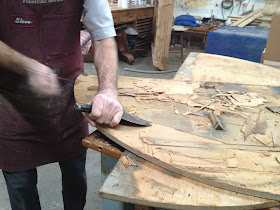We had an unpleasant discovery while working on this Oak Dining Table. The table top was stripped before we did any other work. Once it was dry and we moved on to do the next repair steps we found that there was some dry rot on the underside. -groan- All those dark areas you see
(where the extension slides attach) are dry rot.
To deal with the dry rot we began to pull the damaged layer of veneer of the underside of the table. All the veneer would need to be replaced instead of just the top surface as we had originally planned.
As that veneer came off, it exposed another issue. Bug Damage! Not good. All that powdery stuff is the wood that has been eaten away by bugs. Fortunately there aren't any living bugs still in the table. But now we have to repair all the bug damage, as well as the dry rot damage.
As you can see in the picture, those were some busy bugs! The odd thing about this table is that none of the bug damage was visible until the veneer came off. It was all hidden between the veneer and the hardwood surface. They really are fortunate that there was no bug damage to the top surface as well. It is going to be quite a job to deal with all those bug canals, but never fear, the craftsmen are here to save the day. Before you know it, this table will look amazing again and will be ready for many birthday, christmas, thanksgiving and easter celebrations to come!
(where the extension slides attach) are dry rot.
To deal with the dry rot we began to pull the damaged layer of veneer of the underside of the table. All the veneer would need to be replaced instead of just the top surface as we had originally planned.
As that veneer came off, it exposed another issue. Bug Damage! Not good. All that powdery stuff is the wood that has been eaten away by bugs. Fortunately there aren't any living bugs still in the table. But now we have to repair all the bug damage, as well as the dry rot damage.
As you can see in the picture, those were some busy bugs! The odd thing about this table is that none of the bug damage was visible until the veneer came off. It was all hidden between the veneer and the hardwood surface. They really are fortunate that there was no bug damage to the top surface as well. It is going to be quite a job to deal with all those bug canals, but never fear, the craftsmen are here to save the day. Before you know it, this table will look amazing again and will be ready for many birthday, christmas, thanksgiving and easter celebrations to come!









